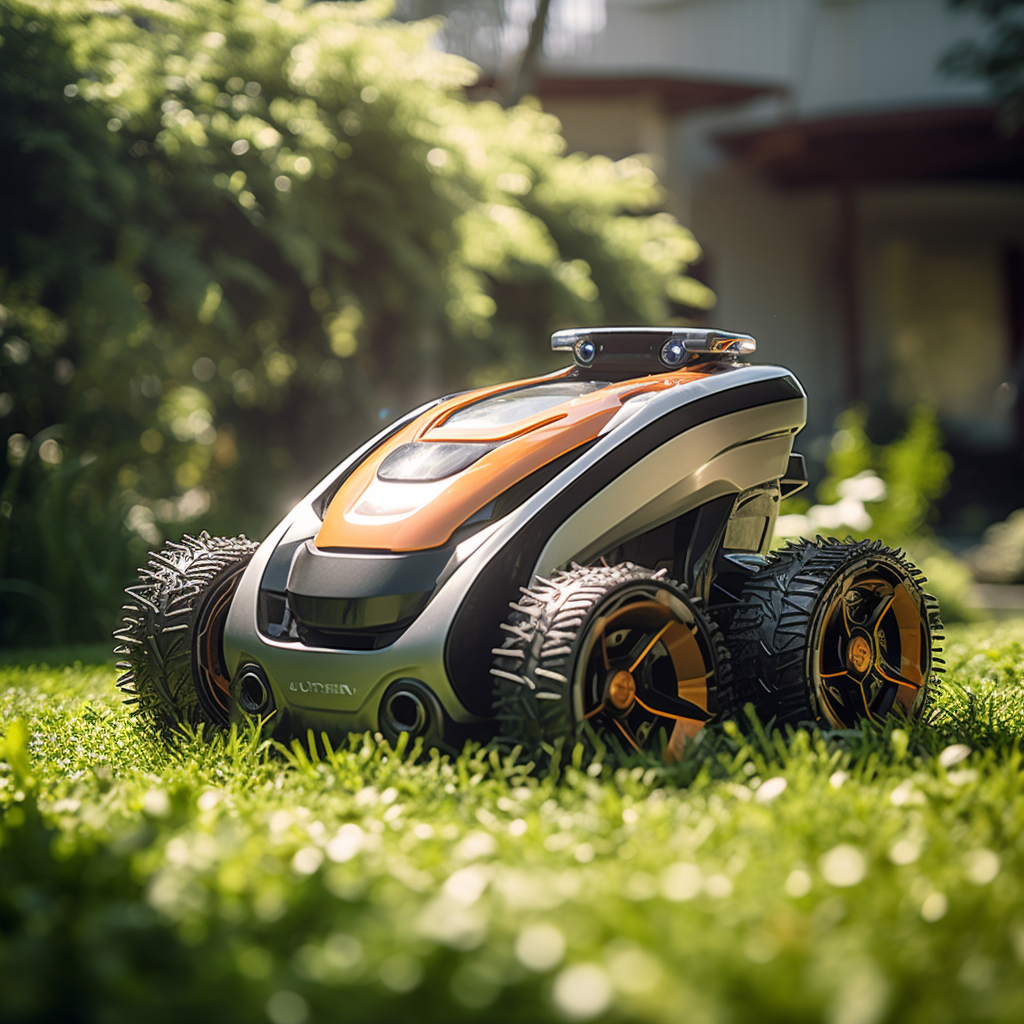In the era of smart homes and automated systems, the concept of lawn care has evolved significantly. Gone are the days when maintaining a lawn was a labor-intensive task. Today, technology has permeated this sphere as well, with the advent of smart lawn mowers. These devices, equipped with advanced features like computer vision and IoT-based sensors, are revolutionizing the way we approach lawn maintenance.
This blog post aims to delve into the world of smart lawn mowers, focusing on the role of computer vision in these devices. We will explore how this technology is being used to make lawn mowing more efficient and less laborious. The discussion will be based on insights from two scientific papers: "Development and Performance Evaluation of a Robot for Lawn Mowing" and "Designing and Manufacturing of Automatic Robotic Lawn Mower". These papers provide a comprehensive understanding of the design, fabrication, and performance evaluation of computer vision-based smart lawn mowers.
In addition to the insights from these papers, we will also look at the latest advancements in commercial smart lawn mowers. This will give us a glimpse into the current state of this technology and its future potential.
Join us as we navigate through the intricacies of computer vision in smart lawn mowers, and explore how this technology is set to redefine the future of lawn care.
Understanding Computer Vision
Computer vision is a field of artificial intelligence (AI) that enables computers to interpret and understand the visual world. By digitally processing and analyzing images, computer vision systems can extract, analyze, and understand useful information from the visual environment.
At its core, computer vision seeks to replicate the complexity of human vision. It involves the extraction of high-dimensional data from the real world to produce numerical or symbolic information that a machine can interpret. This process is achieved through a series of algorithms and techniques that process and analyze images to identify objects, features, and patterns.
In the context of robotics, computer vision plays a crucial role. It allows robots to perceive their environment, which is essential for tasks that require interaction with the physical world. For instance, a robot equipped with computer vision can recognize and locate objects, navigate through its surroundings, and perform complex tasks that would otherwise require human intervention.
In the realm of smart lawn mowers, computer vision is used to enable the mower to navigate through the lawn autonomously. It allows the mower to recognize different objects in its path, differentiate between grass and other elements, and make decisions based on this information. This could involve changing direction upon encountering an obstacle or adjusting the cutting height based on the length of the grass.
In the following sections, we will delve deeper into the application of computer vision in smart lawn mowers, drawing insights from scientific research and recent advancements in commercial products. We will explore how this technology is being used to enhance the efficiency and autonomy of lawn mowing, and what this means for the future of lawn care.
The Role of Computer Vision in Smart Lawn Mowers
Image processing, a well-established field, has found diverse applications in the realm of autonomous robotics. From obstacle detection to visual navigation, various areas leverage its possibilities to enhance the capabilities of autonomous robots.

Sensor fusion
Sensor fusion is a critical component in the functionality of autonomous lawn mowers. By integrating multiple sensors such as LiDAR, cameras, ultrasonic sensors, and GPS, the mower gains a comprehensive understanding of its surroundings. LiDAR provides 3D spatial data, cameras offer visual information, ultrasonic sensors detect nearby obstacles, and GPS aids in global localization and path planning. Through the fusion of these diverse sensor inputs, the autonomous lawn mower can navigate with precision, avoiding obstacles and maintaining efficient mowing patterns, ensuring safe and effective lawn care.
Neural networks
Autonomous lawn mowers have revolutionized lawn care through the integration of advanced neural networks for obstacle detection. Specifically, Convolutional Neural Networks (CNNs) are widely utilized for this task due to their exceptional image processing capabilities. Equipped with onboard cameras, the mower captures real-time video feeds of the lawn's environment. These images are then fed into the CNN, which uses hierarchical layers with convolutional filters to extract essential features like edges, corners, and textures. By training the CNN on extensive datasets containing diverse lawn obstacles, such as trees, bushes, rocks, and other potential hindrances, the network learns to accurately differentiate between them and the grass. The CNN's ability to efficiently process high-dimensional data empowers the autonomous lawn mower to make real-time decisions with remarkable accuracy, ensuring smooth navigation around obstacles and facilitating safe and efficient lawn maintenance.
Recent Advancements in Commercial Smart Lawn Mowers
The commercial smart lawn mower industry has been experiencing significant growth and innovation in recent years. The market size was valued at USD 1.5 billion in 2021 and is expected to reach USD 3.9 billion by 2027, registering a CAGR of about 12% during the forecast period (2022 - 2027). This growth is driven by increasing technological advancements in artificial intelligence and robotics, leading to the creation of more efficient household appliances and reduced human intervention.
One of the major advancements in this field is the integration of artificial intelligence (AI) and machine learning (ML) in lawn mowers. For instance, Bosch uses both AI and ML in its lawn mowers for obstacle identification. These technologies enable lawn mowers to learn about the obstacles and work on the acceleration and orientation for improving performance and better results.
Another significant development is the introduction of GPS technology in smart lawn mowers. For example, Husqvarna’s Automower 435X AWD smart home robotic lawn mowers are equipped with advanced GPS-assisted navigation. This technology allows the mower to navigate the lawn autonomously, improving its efficiency and performance.
In addition to AI, ML, and GPS technologies, manufacturers are also integrating other features such as laser vision, lawn mapping, smart navigation, and self-emptying into their products to improve their performance and efficiency. These features not only enhance the functionality of the mowers but also make them more user-friendly.
Furthermore, the market is witnessing a shift from traditional gasoline-powered manual lawn mowers towards newer, silent, efficient, smart, and battery-powered robotic mowers. This shift is broadening the growth prospects of the market, especially in regions like Europe where there is a high demand for professional lawn mowers, professional landscaping devices, and automated tools.
In conclusion, the world of commercial smart lawn mowers is evolving rapidly with the integration of advanced technologies like AI, ML, and GPS. These advancements are not only improving the efficiency and performance of the mowers but also enhancing the user experience, thereby driving the growth of the market. In the next section, we will discuss the future trends and potential of computer vision in smart lawn mowers.
Future of Lawn Care - what to predict?
The future of computer vision in lawn mowers holds great promise, with advancements in technology poised to revolutionize the industry. Neural networks, the backbone of computer vision algorithms, are continuously evolving to become more sophisticated and lighter. These advancements will lead to improved real-time image processing capabilities, enabling autonomous lawn mowers to detect obstacles with greater accuracy and navigate complex terrains more efficiently.
As battery technology progresses, autonomous lawn mowers will benefit from better energy storage and extended runtimes. Improved batteries allow for more power to be allocated to the GPU, enhancing the mower's computational capabilities for handling complex computer vision tasks. With longer-lasting and higher-capacity batteries, these robotic lawn mowers can operate for more extended periods, covering larger areas without compromising on performance.
Moreover, the development of more sophisticated GPU boards specifically tailored for mobile robots will be a game-changer for computer vision in lawn mowers. These specialized GPU boards will offer optimized processing power for running advanced neural networks, even on resource-constrained devices. The result will be faster and more accurate obstacle detection, smoother navigation, and a more seamless user experience.
With these advancements, the future of computer vision in autonomous lawn mowers looks brighter than ever before. The convergence of more sophisticated and lighter neural networks, better batteries, and specialized GPU boards will undoubtedly elevate the performance and capabilities of these smart lawn care companions, paving the way for greener, more efficient, and autonomous lawn maintenance solutions.
Conclusion
As we navigate through the era of automation and artificial intelligence, the role of computer vision in reshaping various industries becomes increasingly evident. The realm of lawn care is no exception. The integration of computer vision into smart lawn mowers is a testament to the transformative power of this technology.
Through the insights gleaned from scientific research and recent advancements in the commercial sector, we've seen how computer vision enables smart lawn mowers to navigate autonomously, recognize obstacles, and make informed decisions. This technology not only enhances the efficiency and performance of these devices but also significantly reduces human intervention, making lawn care more convenient and less laborious.
Moreover, the recent advancements in commercial smart lawn mowers, such as the integration of AI, ML, and GPS technologies, and the shift towards battery-powered robotic mowers, are indicative of the rapid evolution in this field. These developments are not only improving the functionality of the mowers but also making them more user-friendly and environmentally friendly.
Looking ahead, the impact of computer vision on the future of lawn care is profound. As these technologies continue to evolve, we can expect to see more innovative solutions that will further revolutionize the landscape of lawn care. The future of lawn care is smart, efficient, and sustainable, and computer vision is at the forefront of this transformation.
In conclusion, the integration of computer vision into smart lawn mowers is a significant step toward the future of automated and efficient lawn care. As we continue to embrace these technological advancements, we move closer to a future where lawn care is not a chore, but a seamless part of our smart, connected lives.

